Setting up a DD-WRT connection though an access point.
The following instructions will guide you through a configuration of a PPTP or L2TP connection on a DD-WRT compatible router being used as an access point. There are hundreds of routers compatible with DD-WRT, please check the router database on the DD-WRT website for more information.
IMPORTANT NOTICE: Setting up DD-WRT on a compatible router is not for novice users, this setup does require a certain amount of experience and knowledge of how internal networks operate. It is not possible for VPNUK to assist in the flashing of routers or the installation of DD-WRT firmware. It is also not possible for VPNUK to assist in the setup of the VPNUK service, nor can we be held responsible for damage caused by clients configuring uncompatible routers or flashing incorrect firmware. If you choose to setup your VPNUK connection over DD-WRT we have very limited support available and we are unable to assist remotely or through our Live Help service. Please only install official DD-WRT firmware from the DD-WRT website onto compatible routers. Before you attempt to configure your router please setup an OpenVPN connection on your computer to ensure the account is working.
If you do choose to configure your connection through DD-WRT, please note, that it is still largely unsupported and can be problematic. If you have any problems we only offer basic troubleshooting assistance through our ticketing system, we also have a troubleshooter at the bottom of this page. You should be prepared to lose internet connectivity and be ready and know how to return the router to it’s default settings.
PPTP CONNECTIONS: A 200MHz processor (most routers’ processors) won’t reach an optimal speed for some media related services when using PPTP. We strongly recommend all connections to the VPNUK servers over DD-WRT use the OpenVPN setup, its fast, stable and very secure.
1. Version Check
Login to your router with DD-WRT version v24-sp2 or higher on it.

2. Services
Click on the ‘Setup’ tab

3. Connection Type
Select ‘PPTP’ or ‘L2TP’ from the ‘Connection Type’ dropdown menu.
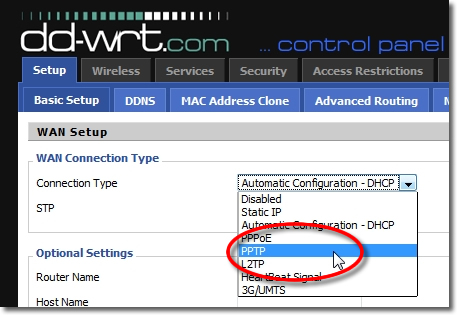
4. Use DHCP
If you chose ‘PPTP’ as the connection type place a check in the ‘Yes’ checkbox for ‘Use DHCP’. L2TP does not have this option, you can move on to the next step.
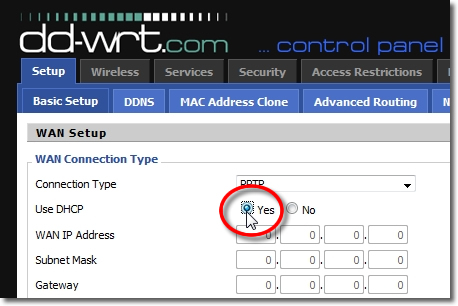
5. Gateway Address
Enter the IP address of your VPNUK server in ‘Gateway (PPTP Server) field’. You can find the server information in your ‘Welcome to VPNUK’ email or in the ‘Client CP‘ on the VPNUK website.
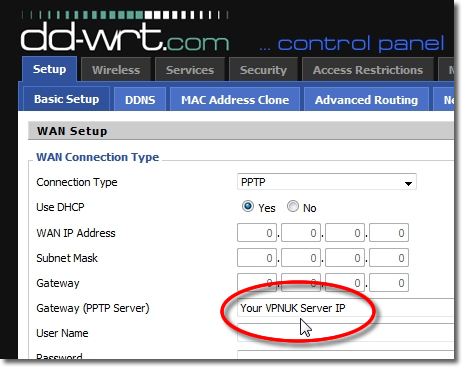
6. Login Details
Enter your VPNUK login username and Password into the ‘User name’ and ‘Password’ fields. These details will have been sent to you in the Welcome email.
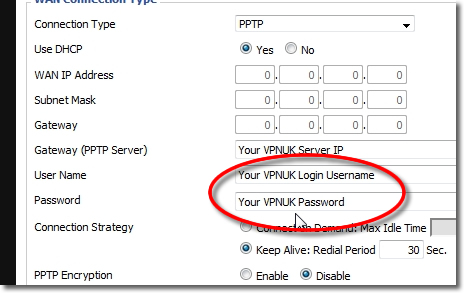
7. PPTP Encryption
If you chose ‘PPTP’ as the connection type, place a check in the ‘PPTP Encryption’ checkbox. L2TP does not have this option.
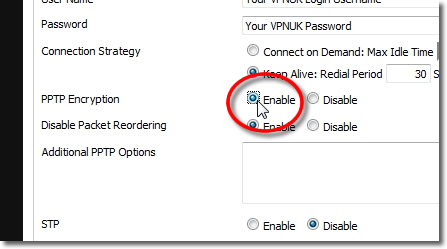
8. STP Settings
Ensure the STP checkbox is set to ‘Disable’.
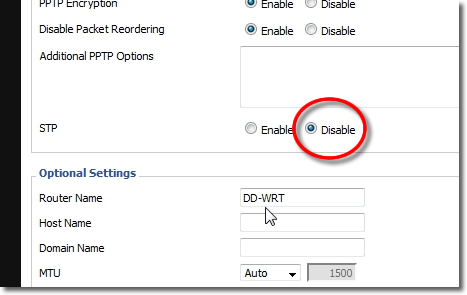
9. Local IP address
Enter an IP address for the DD-WRT access point.
NOTE: You need to choose an IP that will not not conflict with your main routers IP address. For example, if your main router is 192.168.1.1, you can make the access point: 192.168.1.51
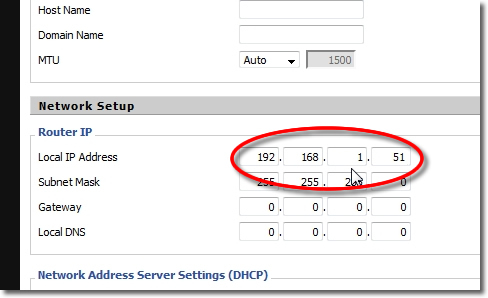
10. Subnet mask
Set the ‘Subnet Mask’ to ‘255.255.255.0’.

11. Enable DHCP server
Enable the ‘DHCP Server’ and ensure the ‘Start IP Address’ is one higher than the router IP.
Note: You can leave the static DNS on 0.0.0.0 for Default DNS. This screenshot uses Google DNS.

12. DHCP & DNS Settings
Uncheck all three checkboxes for ‘Use DNSMasq for DNCP’, ‘Use DNSMasq for DNS’ and ‘DHCP-Authoritative’.

13. Save the Setting
Click the ‘Apply Settings’ Button.
Note: If you changed the IP address of the DD-WRT router in part 9 the DD-WRT administration area will be at that URL once the settings have been applied.

14. Security Settings
Click on the ‘Security’ button in the menu at the top of the page.

15. Disable Firewall
Select the ‘Disable’ checkbox in the SPI Firewall.

16. Apply Settings
Click onto the ‘Apply Settings’ button in order to save the changes.

17. VPN Passthrough
Click onto the ‘VPN Passthrough’ button.

18. PPTP Passthrough
Ensure the ‘PPTP passthrough’ button is set to ‘Enable’.

19. Apply Settings
Click onto the ‘Apply Settings’ button in order to save the changes.

20. Complete Setup
Click onto the ‘Administration’ button.
21. Reboot DD-WRT
Scroll down to the bottom of the page and click on the ‘Reboot Router’ button.
Note: It’s a good idea to reboot your main router also.

22. Check connection
If you have not already done so you must connect your DDWRT router WAN port to your modem or to the LAN port on your main router.
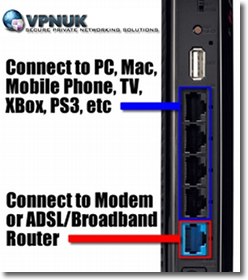
23. Connected to VPNUK
Your DD-WRT router will now reboot. Once rebooted you should be connected to the VPN.
Note: If the ‘Login Status’ says ‘Disconnected’ click onto the ‘Connect’ button and wait.

Troubleshooting DD-WRT Issues
There are many reasons why a DD-WRT connection may fail to connect correctly. The most common issues are down to little errors like the incorrect VPNUK login username, password and server details, even having the incorrect time and date can impact on the connections.
Here is a checklist of common causes and fixes.
1. Try setting ‘Use DNSMasq for DNCP’, ‘Use DNSMasq for DNS’ and ‘DHCP-Authoritative’ to enabled as well as disabled.
2. Ensure the IP of the DD-WRT router is not conflicting with your main router. If your main router is currently 192.168.1.1 DD-WRT has to be in the same subnet, an example of ithis is: 192.168.1.51
3. Ensure the DD-WRT is connected to any other router from its WAN port.
4. You could also try setting the DD-WRT router to a ‘Static’ connection from the ‘Basic Setup’ page.
5. Go to your LAN settings and manually change your IP Address, Subnet Mask and Gateway so its pointing to the DD-WRT router.
You may also need to change the DNS servers, if you do not want to use your ISPs DNS you can use Google DNS 8.8.8.8 and 8.8.4.4
6. If you have setup a PPTP connection try adding: mppe required,no40,no56,stateless into the ‘Additional PPTP Settings’ text area.
7. If you have setup a PPTP connection please ensure the PPTP passthrough is enabled from Security -> VPN Passthrough.
8. Try disabling the firewalls on your routers or modems, these can quite often cause connection issues. Once its determined that a firewall is not causing the problem it can always be re-enabled.
9. MTU settings can quite often cause problems, you could try lowering the MTU settings by adding this command on a new line (below verb 3) on your OpenVPN configuration file: tun-mtu 1100
10. Its very important that your router has the correct time and date.
OpenVPN Log Instructions
If you are running an OpenVPN Connection you can create a Log which may enable you to see the problem, or you can open a support ticket and send us the details.
1. Add the following after ‘verb 3’ in your OpenVPN Config startup script:
log /tmp/openvpn.log
2. Reboot you router, wait for about 5 minutes and then run the following command (Run Command) from the command text area in administration (same place as the OpenVPN config file):
ln -s /tmp/openvpn.log /tmp/www/openvpnlog.html
3. Go to the DD-WRT index page and add: /user/openvpnlog.html to it so it looks something like: http://192.168.x.x/user/openvpnlog.html
## If any problems persist please open a support ticket and we will be able to assist you with our troubleshooting questionaire.
